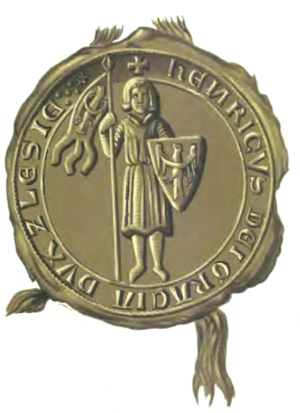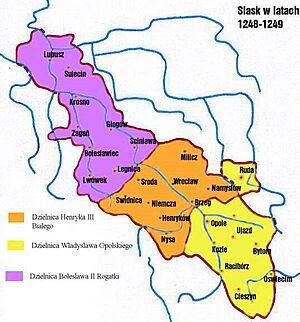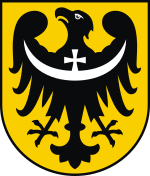Henry III the White facts for kids
Quick facts for kids Henry III the White |
|
|---|---|

Seal of Duke Henry III
|
|
| Duke of Silesia-Wrocław | |
| Reign | 1248–1266 |
| Predecessor | Bolesław II Rogatka |
| Successor | Henryk IV Probus |
| Born | c. 1227/1230 |
| Died | 3 December 1266 |
| Spouse | Judith of Masovia Helene of Saxony |
| Issue | Henryk IV Probus |
| House | Silesian Piasts |
| Father | Henry II the Pious |
| Mother | Anne of Bohemia |
Henry III the White (also known as Henryk III Biały in Polish) was an important duke from the Silesian Piasts family. He was born around 1227 or 1230 and passed away on December 3, 1266. From 1248 until his death, he ruled as the Duke of Silesia in Wrocław, sharing power with his brother Władysław.
Contents
Life of Henry III
Henry III was the third son of Henry II the Pious, a powerful Polish duke. His mother was Princess Anna, daughter of King Ottokar I of Bohemia. When Henry III's father died bravely in the Battle of Legnica in 1241, Henry was still young. He and his younger brothers, Konrad and Władysław, were cared for by their mother.
In 1242, his brother Mieszko died unexpectedly. This made Henry III the second oldest brother, right after Bolesław II the Bald. From then on, Henry III became a leader against his older brother Bolesław II in Lower Silesia.
Becoming the Duke of Wrocław
Henry III first appeared as an adult in 1247. However, Bolesław II did not want to share power with him. Bolesław only changed his mind after his brothers rebelled and even captured him. Henry III then became a co-ruler with his older brother.
The brothers did not work well together. A year later, Henry III pushed for a division of their lands. They split the areas of Legnica–Głogów–Lubusz and Wrocław. Bolesław, being the older brother, chose Legnica. He picked it because gold had been found in the nearby Kaczawa and Wierzbiak Rivers.
Bolesław II might have hoped that Henry III would struggle with Wrocław. He thought the Duchy would eventually return to him. But this did not happen. Henry III was a strong ruler. He quickly gained control over the powerful nobles. Part of their agreement was to host their younger brothers, Konrad and Władysław. Both were meant to become priests.
Henry III successfully encouraged Władysław to join the Church. This was very different from Bolesław's relationship with Konrad. Bolesław and Konrad had many arguments. Konrad wanted his own land and refused to become a priest. It was only a matter of time before open war broke out. Henry III supported Konrad against Bolesław II.
Conflicts and Alliances
Bolesław II lacked money and feared fighting his brothers. To get funds for war, he sold half of Lubusz to the Archbishop of Magdeburg. Henry III also sought allies, finding them among the rulers of Meissen.
Defeated, Bolesław II had to give the Głogów area to Konrad. Konrad then tried to force Henry III to intervene in Legnica in 1250. When Konrad kidnapped Bolesław II, even Henry III thought it was too much. Henry III tried to avoid open conflicts with his brothers. It was only in 1253, when Bolesław II's power completely failed, that Henry III helped him return to his Duchy.
Between the 1250s and 1260s, Henry III became the most powerful Piast Duke in Lower Silesia. He became active in international politics. Henry III formed alliances with his relatives, the Dukes of Opole and Głogów. He also allied with the Kings of Bohemia, Wenceslaus I and Ottokar II. Henry III visited the royal court in Prague several times.
However, his cooperation with Bohemia did not bring the expected results. Bohemia decided to get involved in a dispute over Austria. Henry III then reaffirmed his alliance with Bohemia. He ended his treaty with the rulers of Greater Poland, Przemysł I and Bolesław the Pious, and the Árpád dynasty.
They decided to punish Henry III. From 1253 to 1254, the Duchy of Wrocław was attacked and looted. Attempts to force Henry III to make concessions failed. This included blackmail in 1256 and bribery in 1262.
Internal Rule and Challenges
Inside his Duchy, Henry III worked to protect the rights of the Piast family. The church strongly supported him. This was because Henry III backed Bishop Thomas of Wrocław against Bolesław II in their arguments.
This policy did not please the nobles of Wrocław. By 1266, several riots broke out among the nobles and knights. These events may have contributed to the Duke's early death.
Henry III's rule also saw many German settlers come to Lower Silesia. This greatly helped his Duchy grow and become wealthy. Many new cities were founded during this time. A large castle was also built in Ostrów Tumski in Wrocław. Henry III also generously supported artists at his court. In the 13th century, German was a common language for politics.
Revolt of 1266
Henry III's strict internal policies led to a rebellion by the townspeople. The reason for the revolt appeared in mid-1266. They tried to force a division of the Duchy of Wrocław. They wanted to split it between Henry III and his brother, Archbishop Władysław of Salzburg. Władysław was surprised by this and was not leading the revolt. The rebellion likely started among the nobles.
Polish historian Jerzy Mularczyk suggested two possible leaders for the revolt. One was Bishop Thomas of Wrocław. He might have tried to strengthen the church's position. He feared that Henry III, who was taking power from the nobles, would also do the same to the Church.
The second possible leader was Bolesław II the Bald. He hoped that if Wrocław was divided, and if Władysław died without heirs (since he was a priest), Bolesław might get back part of Wrocław. A document showed a close link between Bishop Thomas and Bolesław II. However, there is no direct proof for this idea. Little is known about the revolt of mid-1266, but it failed, and the Duchy was not divided.
Henry III's Death
Henry III did not have much time to celebrate his success. Only a few months later, he died suddenly at just thirty-nine years old. As often happens in such cases, rumors of poisoning quickly spread. This was mentioned in the Kronika polska, a chronicle written by a monk named Engelbert around 1283–1285.
The idea that he died under unusual circumstances suggests that some Silesian Dukes might have plotted against him. This idea is not without reason. Henry III spent his last months fighting against internal opposition. There was likely a large group of people who were unhappy with the Duke's punishments after the revolt. They might have decided to remove him.
It seems unlikely that Bishop Thomas or Bolesław II the Bald were involved in his death. Their benefits from Henry III's death were small. Wrocław passed to Henry IV, who was still a child. Archbishop Władysław became his regent, and he continued his late brother's policies. Henry III's dying wish for Władysław to be regent was likely to reduce suspicion against Władysław. The people truly responsible for his death were probably knights unhappy with his rule or those who wanted Wrocław divided.
Besides the Kronika polska, Henry III's mysterious death was also written on his tombstone. It stated that he died by poison. This information was then passed down through other historical writings.
The year of Henry III's death is certain, confirmed by all records. However, the exact date varies. December 3 is considered the most likely date, though some sources mention December 1, December 5, or November 29. Henry III was buried in the Clare Church in Wrocław, which was still being built.
Family Life
On June 2, 1252, Henry III first married Judith. She was the daughter of Duke Konrad I of Masovia and the widow of Mieszko II the Fat, Duke of Opole. They had two children:
- Hedwig (born around 1256 – died after December 14, 1300). She married Henry, Lord of Pleissnerland and later Otto I, Prince of Anhalt-Aschersleben.
- Henry IV Probus (born around 1258 – died June 24, 1290).
Shortly before his death in 1266, Henry III married a second time to Helena. She was born in 1247 and died on June 12, 1309. Helena was the daughter of Albert I, Duke of Saxony. They did not have any children.



